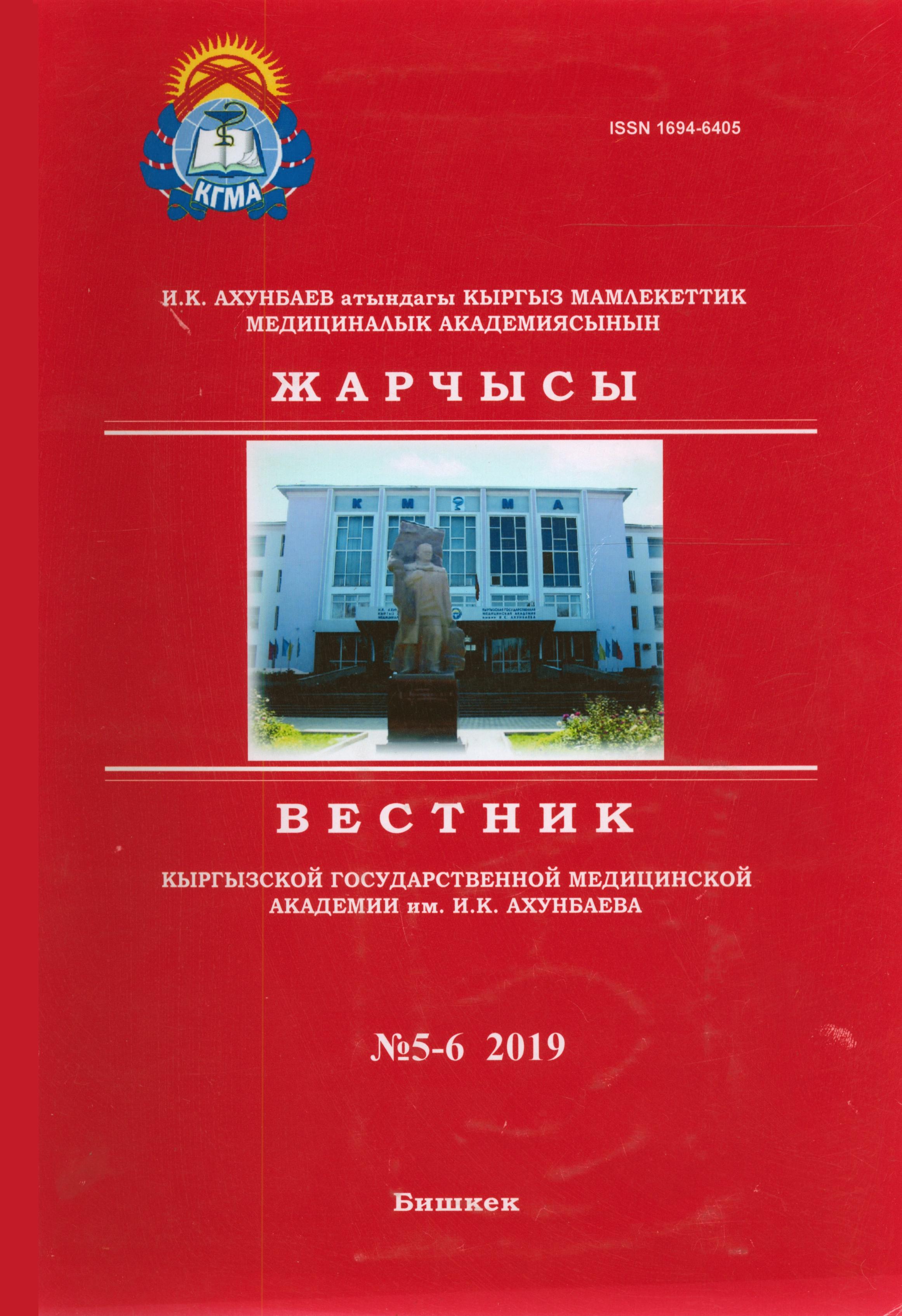АДАМДЫН МИКРОБИОТУ ЖАНА АНЫН МААНИСИ
Аннотация
Аннотация. Бул макалада микробиоттордун замандап макаласы берилген. Микробиот - бул адамдардын нормада жана патологияда боло турган микроорганизммдердин бирге болуусу жана алардын физиологиялык жана патологиялык реакцияларда, ошондой эле дары дармектердин, горомондордун зат алмашуусунда катышышат. Адамдардын микробиотун курамына бир канча козу карындар, эубактериялар, архейлер жана вирустар кирет. Адамдын организмдеги эубактериялардын микробиоту адамдын өздүк клеткасынын курамынан 10 трилиондон, бул жүз эсе көбүрөөк санын түзөт. Заманбап изилдөөчү ыкмалардын өнүгүшү менен жогорку деңгээлдеги гендик изилдөөчү ыкмалардын (секвенирование) жардамы аркылуу анык, так жана комплекстүү балоонун натыйжасында жалпы микробдук улушун, пайызын аныктоого мүмкүнчүлүк бар. Бул мүмкүндүк адамдын организмминин микробиоттор менен өз ара байланышып жаңы деңгээлге чагара келди.
Ключові слова:
микробиот, микроорганизм, ичегинин микробиоту, генди изилдөөчү ыкма (секвенирование).Посилання
1. Socransky SS, Gibbons Rd, Dale AC. The microbiota of the gingival crevice area of man.I.Total microscopic and viable counts of specific microorganisms. J.Arch Oral Biol.1953; 8: 275-280.
2. The human microbiome project consortium Structure, function and diversity of the healty human microbiome. Nature, 2012; 486: 207-214.
3. Metagenomic characterization of the human intestinal microbiota in fecal samples from stec-infectedpatients / [F. Gigliucci, F.A. Bas- tiaan Von Meijenfeldt, A. Knijn et al.] // Front cell infect microbiol. - 2018. - Vol. 8. - P. 25.
4. Jingyuan F, Bonder M., Carmen Cenit M. et al. The Gut Microbiome Contributes to a Substantial Proportion of the Variation in Blood Lipids. Circulation Research. 2015; 117: 817-24.
5. Backhed F., Ding H., Wang T. et al. The gut microbiota as an environmental factor that regulates fat storage. ProcNatl Acad Sci USA. 2004;44:1 5718-23.doi:10.1073/pnas0407076101.
6. Ridaura V.K., Faith J.J., Rey F.E., Cheng J.Gut microbiota from twins discordant for obesity modulate metabolism in mice. Science. 2013;341 (61 50):1241214.
7. Pluznick J. Microbial Short-Chain Fatty Acids and Blood Pressure Regulation. Curr Hypertens Rep. 2017;19(4):25. doi: 10.1007/s1 1906-017-0722-5.
8. Черневская Е.А., Белобородова Н.В. Микробиота при критических состояниях (обзор). Ж. Общая реаниматология.2018;14(5)96-119.
9. Virgin HW. The virome in mammalian physiology anddisease.Cell.2014;157: 142150.
10. Sekirov I. et al. Gut Microbiota in Health and Disease // Physiol. Rev. 2010. Vol. 90. №3.
11. Mshvildadze M., Neu J. The infant intestinal microbiome: Friend or foe? // Early Hum. Dev. 2010. Vol. 86. №1. P.67-71.
12. Булатова Е., Богданова Н., Лобанова Е. Кишечная микробиота: современные представления // Педиатрия. 2009. Т.87. №3. С.104-110.
13. Mackie R.I., Sghir A., Gaskins H.R. Developmental microbial ecology of the neonatal gastrointestinal tract. // Am. J. Clin. Nutr. American Society for Nutrition, 1999. Vol. 69. №5. P.1035S-1045S.
14. Jakobsson H.E. et al. Decreased gut microbiota diversity, delayed Bacteroidetes colonisation and reduced Th1 responses in infants delivered by Caesarean section // Gut. 2014. Vol. 63. №4. P.559-566.
15. Arora T., Bdckhed F. The gut microbiota and metabolic disease: current understanding and future perspectives // J. Intern. Med. 2016. Vol. 280. №4. P.339-349.
16. Шендеров Б.А. Нормальная микрофлора и ее роль в поддержании здоровья человека // Российский журнал гастроэнтерологии, гепатологии, колопроктологии. 1998. № 1. С. 61-66 Shenderov B.A. Normal'naja mikroflora i ee rol' v podderzhanii zdorov'ja cheloveka // Rossijskij zhurnal gastrojenterologii, gepatologii, koloproktologii. 1998 № 1.S.61-66.
17. Zoetendal E.G., Vaughan E.E., de Vos W.M. A microbial world within us // Mol Microbiol. 2006. Vol. 59. P. 1639-1650.
18. Шендеров Б.А. Функциональное питание и его роль в профилактике метаболического синдрома. М.: ДеЛи Принт, 2008.319 с.
19. Schiffrin E., Rochat F. et al. Immunomodulation of blood cells following the ingestion of lactic acid bacteria // J. Dairy Sci. 1995. Vol. 78. P. 491-497.
20. Shui W., Gilmore S.A., Sheu L. et al. Quantitative Proteomic Profiling of Host- Pathogen nteractions: The Macrophage Response to Mycobacterium tuberculosis Lipids // JProteome Res. 2009. Vol. 8(1). P. 282-289.
21. Ардатская М.Д., Минушкин О.Н., Иконников Н.С. Дисбактериоз кишечника: понятие, диагностические подходы и пути коррекции. Возможности и преимущества биохимического исследования кала: Пособие для врачей. М., 2004.
22. Falony G, Joossens M, Vieira-Silva S, Wang J, Darzi Y, Faust K, et al. Population- level analysis of gut mlcrobiome variation. Science. 2016 Apr 29; 352 (6285): 560-564.
23. Kulagina EV, Efimov BA, Maximov PY, Kafarskaia LI, Chaplin AV, Shkoporov AN. Species Composition of Bacteroidales Order Bacteria in the Feces of Healthy People of Various Ages. Biosci Biotechnol Biochem. 2012; 76 (1): 169-171.
24. De Filippo C, Cavalieri D, Di Paola M, Ramazzotti M, Poullet JB, Massart S, et al. Impact of diet in shaping gut microbiota revealed by a comparative study in children from Europe and rural Africa. Proc Natl Acad Sci U S A. 2010 Aug 17; 107 (33): 14691-6.
25. Tyakht AV, Kostryukova ES, Popenko AS, Belenikin MS, Pavlenko AV, Larin AK, et al.Human gut microbiota community structures in urban and rural populations in Russia. Nat Commun 2013; 4: 2469.
26. Rooks MG, Garrett WS. Gut microbiota, metabolites and host immunity. Nat Rev Immunol. 2016May 27; 16 (6): 341-52.
27. Костюкевич А.А. Былова Н.А., Симбирцева А.С. Роль кишечной микробиоты в развитии заболеваний печени и желчновыводящих путей. РМЖ№17. 713-720.
28. Goodacre R. Metabolomics of a superorganism Natr.2007 Vol.137 259-266. Родни Дитерт. Человеческий суперорганизм. Свешников В., перевод на русский язык,2016. 2016 КоЛибри.
29. Evans JM,Morris LS,Marchesi JR.The gut microbiome: the roleof a virtual organ in the endocrinology of the host. J Endo- crinol.2013Aug28; 218(3):R37-47.
30. Clarke G, Stilling RM, Kennedy PJ, Stanton C, Cryan JF, Dinan TG. Minireview: Gut Microbiota: The Neglected Endocrine Organ. Mol Endocrinol. 2014 Aug; 28 (8): 1221-38.
31. Rooks MG, Garrett WS. Gut microbiota, metabolites and host immunity. Nat Rev Immunol. 2016May 27; 16 (6): 341-52.
32. Чаплин А.В., Ребриков Д.В. Болдырева М.Н. Микробиом человека. Ж. Вестник Российского государственного универститета,2017.
33. Rooks MG, Garrett WS. Gut microbiota, metabolites and host immunity. Nat Rev Immunol. 2016May 27; 16 (6): 341-52.
34. Canfora EE, Jocken JW, Blaak EE. Short-chain fatty acids in control of body weight and insulin sensitivity. Nat Rev Endocrinol. 2015 Oct; 11 (10): 577-91.
35. Arumugan M. , Raes J., Pelletier E., Le Paslier D., Yamada T., Mende D.R. et al. Enterotypes the human gut microbiome. Nature. 2011; 473 (7346): 174-180.
36. Panda S, Guarner F, Manichanh C. Structure and functions of the gut microbiome. Endocr Metab Immune Disord Drug Targets. 2014;14 (4) :290-299.
37. PimentelM, Mathur R,Chang C.Gas and the microbiome. Curr Gastroenterol Rep. 2013;15(12):356.https:// doi.org/10.1007/s1189 4-013-0356-у.
38. Giles K, Pluvinage B, Boraston AB. Structure of a glycoside hydrolase family 50 enzyme from a subfamily that isenriched in human gut microbiome bacteroidetes. Proteins. 2017; 85 (1):182-187.
39. Gloux K, Leclerc M, Iliozer H, et al. Development of high-throughput phenotyping of metagenomic clones from the human gut mi- crobiome for modulation of eukaryotic cellgrowth. Appl Environ Microbiol. 2007;73 (11):3734-3737.
40. Sudo N. Microbiome, HPA axis and production of endocrine hormones in the gut. Adv Exp Med Biol. 2014;817:177-194.
41. Wolf A, Moissl-Eichinger C, Perras A, et al. The salivary microbiome as an indicator of carcinogenesis in patients with oropharyngeal squamous cell carcinoma: A pilot study. Sci Rep.2017;7(1):5867.
42. Martz S-LE, McDonald JAK, Sun J, Zhang Y-G, Gloor GB, Noordhof C, et al. Administration of defined microbiota is protective in a murine Salmonella infection model. Sci Rep. 2015;5: 16094.
43. Kamada N, Seo S-U, Chen GY, Nunez G. Role of the gut microbiota in immunity and inflammatory disease. Nat Rev Imm. 2013;13: 321-335.
44. Pluznick J.L., Protzko R.J., GevorgyanH. et al. Olfactory receptor responding to gut microbiota-derived signaks plays a role in rennin secretion and blood pressure regulation. Proc. Natl. Acad. Sci. USA 2013; 110: 4410—5.
45. Айтбаев К.А., Муркамилов И.Т. Кишечная микробиота в патогенезе артериальной гипертензии. Клиническая медицина.2017; 95(2)173
46. Kashtanova D.A., Tkacheva O.N., Boytsov S.A. Intestinal microbiota and the factors of cardiovascular risk. Part 1. Intestinal microbiota, age and gender. Kardiovaskul- yarnaya terapiya i profilaktika.2015; 14(4): 92—5.
47. Haq K., McElhaney J.E. Immunosenes- cence: Influenza vaccination and the elderly. Curr. Opin. Immunol. 2014; 29: 38— 42.
48. Tiihonen K., Tynkkynen S., Ouwehand A., Ahlroos T., Rautonen N. The effect of ageing with and without non-steroidal antiinflammatory drugs on gastrointestinal microbiology and immunology. Br.J.Nutr.2008; 100(1):130-137.
49. Микробиология. Под ред.А.А.Воробьева МИА. 2012; 88-93.



